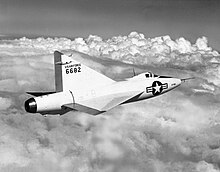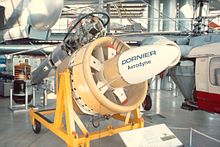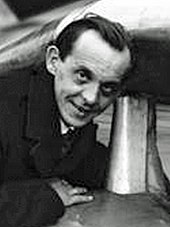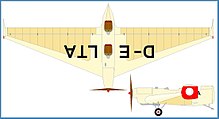Alexander Lippisch
Alexander Martin Lippisch (born November 2, 1894 in Munich , † February 11, 1976 in Cedar Rapids , Iowa , USA ) was a German aircraft designer active in Germany and the USA. He was a pioneer of brushless aircraft , rocket aircraft, and performance glider construction . In particular, he developed the first delta wing aircraft suitable for air travel.



origin
His parents were the painter Franz Lippisch (1859–1941) and his wife Clara Commichau (1856–1942), a daughter of the industrialist Rudolf Commichau from Białystok and the Blanca von Hane. Franz Lippisch was a co-founder of the Berlin Secession and later lived as a landscape painter in Jamlitz (Niederlausitz); his daughter Bianca Commichau-Lippisch (1890–1968), Alexander Lippisch's sister, was also a painter.
Life
Lippisch was an aerial photographer and cartographer from 1915 to 1918 during the First World War. He began his career as an aircraft designer as an aerodynamicist at the Zeppelin works under Claude Dornier . In 1922 he built the tailless glider Espenlaub E2 with Gottlob Espenlaub . He gained experience in gliding, among other things as head of the design office of the Rhön-Rossitten-Gesellschaft (RRG) and soon specialized there in the development of tailless aircraft such as the Storch series (Storch I to IX + DFS 38 "Quo Vadis") and the Delta series (Delta 1 to Delta IVc = DFS 39 ) and DFS 40 "Delta V".
In addition to his tailless designs, numerous revolutionary normal gliders such as the “Professor” (the professor prototype “Rhöngeist” won the Rhön gliding competition in 1928), the “Wien” or the DFS Fafnir from 1931 or Fafnir II “Sao Paulo”. His assistant Hans Jacobs had the task of working out the detailed constructions. After Jakobs took over the glider construction department, Lippisch got its own area especially for tailless aircraft. Günther Groenhoff and later Heini Dittmar and Rudolf Opitz were available as test and development pilots .
One of the projects he oversaw at RRG was the “Delta IV” aircraft type. The Delta IV or Fieseler F3 Wasp turned out to be a problematic design, broke several times and was repeatedly rebuilt and improved. By working with Dittmar, it gradually succeeded in mastering the problems of flying wing aerodynamics. When the machine had overcome its teething troubles as DFS 39 , Lippisch's knowledge of tailless designs had grown considerably. Lippisch himself described the DFS 39 (and not the DFS 194) as the true predecessor of the Me 163 .
In 1928 his duck plane Ente with Fritz Stamer at the controls carried out the first flight with jet propulsion (powder rockets). In the meantime, Heinkel had dealt with liquid rockets in particular and equipped several He-112 cells with such an additional drive and tested them with Erich Warsitz at the wheel.
Project X
Since the tailless design seemed ideal for rocket aircraft , the DFS 194, originally conceived as a brushless propeller aircraft, was modified to play the role of a test vehicle for a liquid rocket motor. The military development of the so-called "Project X" to a rocket-propelled interceptor led in January 1939 to the affiliation of Lippisch's design office (as Department L) to the Messerschmitt factory in Augsburg. At the same time, Heinkel was working “semi-officially” on the He 176 , which took off for the first time six months later with Erich Warsitz at the wheel. The Reich Aviation Ministry (RLM) was not very impressed by Heinkel's solo effort and Ernst Udet forbade further attempts with this aircraft, because "Project X" had priority in this matter.
The flight tests of the "DFS 194" with rocket engine began in summer 1941. A Walter R 1-203 rocket engine with 300 kp (2.9 kN) thrust was used, with which the aircraft reached 550 km / h. The DFS 194 was a forerunner of the Messerschmitt Me 163 and was already very similar to its first prototype, the Me 163 A V4. The first flight attempts with the Me 163 A showed excellent flight characteristics and Dittmar reached speeds of over 800 km / h in gliding flight. Udet attended one of these test flights in Augsburg and was impressed. Now the RLM urged the fastest possible development of an operational model and approved the construction of 70 prototypes.
However, the relationship between Messerschmitt and Lippisch deteriorated; and even before the Me 163 B had completed its first flight with an engine, Lippisch left the Messerschmitt works. In 1943 he was made head of the "Aviation Research Institute" in Vienna. There he experimented, among other things, with the concept of the delta wing and with ramjet engines that were supposed to use coal dust as fuel. For this he designed the groundbreaking Lippisch P.13a prototype .
post war period
After the Second World War , Lippisch was recruited by the US as part of Operation Overcast . He was used there as a consultant for the Air Materiel Command . Although his name does not appear on any official NACA document, it is very likely that he was involved in the wind tunnel tests with the DM-1 in Langley, the prototype of which was realized by the end of the war and brought to the United States for wind tunnel tests after the war .
In 1950 Lippisch moved to the Collins Radio Company , which at the time had its own aircraft department and stayed there until 1964. In 1963 at the Collins Hydrodynamic Laboratory, he was the first to undertake partially successful tests with an X-112 ground effect vehicle . In 1969 Lippisch continued his attempts in Germany at Rhein-Flugzeugbau , and in 1970 his design RFB X-113 undertook the first successful flight of a ground-effect vehicle. In 1972 the unmanned Dornier Aerodyne flew , which had been developed at Dornier with the participation of Lippisch . Shortly after Lippisch's death in 1977, the RFB X-114 began testing. After Lippisch's death, his findings were used for the development and testing of new ground-effect aircraft. Several projects are currently being pursued worldwide, the shape of which goes back to the first prototype X-112.
effect
His designs and conceptual ideas significantly influenced the development of fighter aircraft at the Consolidated Vultee Aircraft Corporation . First the Convair XF-92 was created here as a prototype. From this the Convair F-102 and, as a successor, the Convair F-106 were built as successful fighter aircraft in series. The supersonic Convair B-58 strategic bomber was also created as a delta wing . These aircraft all set a number of aviation records, some of which are still in use today.
literature
- Hans Christoph Graf von Seherr-Thoss: Alexander Lippisch. In: New German Biography (NDB). Volume 14, Duncker & Humblot, Berlin 1985, ISBN 3-428-00195-8 , pp. 662-664 ( digitized version ).
- Alexander Lippisch, Fritz Trenkle : A triangle flies - The history of the Delta aircraft up to 1945. Motorbuch-Verlag, Stuttgart 1976, ISBN 3-87943-467-0 .
- Flugsport - illustrated aviation magazine for the entire flight being . In: Carl Oskar Ursinus (Ed.): Flugsport . Verlag für Flugsport, Frankfurt am Main 1920 ( Flugsport in the luftfahrt-bibliothek.de [accessed on March 5, 2020]).
Web links
- Biography and many pictures
- Literature by and about Alexander Lippisch in the catalog of the German National Library
Individual evidence
- ↑ Aviation 1928 No. 18, 29 August 1928 , p. 346
- ↑ Hans Christoph Graf von Seherr-Thoß: New German Biography, Volume 14 . 1985 ( deutsche-biographie.de [accessed March 6, 2019]).
- ↑ Bill Yenne: Convair Deltas. Specialty Press, 2009, ISBN 978-1-58007-118-5 , p. 13.
| personal data | |
|---|---|
| SURNAME | Lippisch, Alexander |
| ALTERNATIVE NAMES | Lippisch, Alexander Martin (full name) |
| BRIEF DESCRIPTION | German aircraft designer |
| DATE OF BIRTH | November 2, 1894 |
| PLACE OF BIRTH | Munich |
| DATE OF DEATH | February 11, 1976 |
| Place of death | Cedar Rapids , Iowa , USA |








